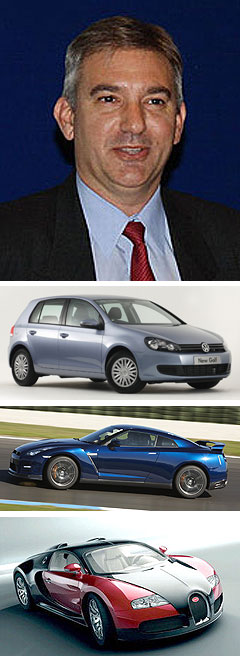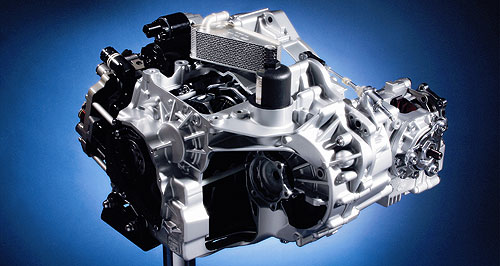News - General News - PartsThe Aussie behind an auto innovationHappy client: Volkswagen makes around one million DSG dual-clutch transmissions each year. How an Australian engineer helped VW take the lead in dual-clutch transmissions11 Jul 2011 By IAN PORTER THE dual-clutch transmission popularised by the Volkswagen Group – seen as a small miracle when it appeared – may not have seen the light of day had it not been for Australian engineer Ric Tamba. Delivering lightning gear changes, more driver control and better fuel economy the DCT was hailed as another masterpiece of German engineering and cited as one of the reasons why the VW group continued to thrive as others crumbled in the face of waves of cheap Asian competition. In fact, it was only the assistance of Mr Tamba, who cut his teeth at the Borg-Warner plant in Albury in the 1980s before joining US engineering group Ricardo as a global transmission troubleshooter, that got the dual-clutch phenomenon off the ground. Now free of legal prohibitions on talking about his role in the VW project, last week he detailed his experience at a technical conference promoted by the Cooperative Research Centre for Advanced Automotive Technology as part of Victoria’s Automotive Week. “One night I was in a bar with a friend, an electronics engineer also from Australia and also contracted to Ricardo, and we asked ourselves why were we doing it for someone else. Why don’t we do it for ourselves?”  Left: Ric Tamba. Below: Volkswagen Golf, Nissan GTR and Bugatti Veyron. Left: Ric Tamba. Below: Volkswagen Golf, Nissan GTR and Bugatti Veyron.They started Nautitech, which also did marine and industrial/mining work, and worked for several international car-makers designing and prototyping transmissions and seeing them into production. In 1998, Mr Tamba got a call from the vice-president of engineering at Borg-Warner in the US, Erich Wilfinger – the man who had hired him in Albury. Mr Wilfinger had Volkswagen on the line wanting some help with its pioneering dual-clutch transmission technology. DCT had been around with Porsche in racecars since the 1960s, but a racecar only launches once or maybe a few times from pit stops, and smoothness was not required. VW needed the system to handle multiple launches smoothly. Mr Tamba told the conference in Melbourne his team spent a lot of time with VW trying to develop this DCT technology and scoured the world for the right technology, but came up short. “We found clutch technology was available, we found pump and hydraulic technology was available, but controls were not there. We had no software controls, we had no electro-hydraulic actuators available, so I had to design a new electro-hydraulic solenoid for the clutch. “We raised a patent on it, which these days is owned by Borg-Warner, and that is basically the same technology used on most DCTs today.” VW was happy with the result and is now making around one million DCTs a year. And Borg-Warner quickly signed Nautitech to an exclusive contract that lasted for seven years – preventing the company from designing a DCT for anyone else. “They paid us a lot of money every year not to work for anyone else,” said Mr Tamba. “All up, we did 12 DCTs for car-makers, of which the more famous are the VW units, the Nissan GTR and the Bugatti Veyron. “Ricardo of the UK and US get a lot of credit for the Veyron and they deserve it. They did a lot of the transmission design. “However, what they don’t tell you is that the clutch and the valve body was actually designed in Australia by Nautitech.” Nautitech designed DCTs and automatic transmissions for a wide range of car-makers, including Ferrari, Hyundai, VW, GM, Ford/Getrag, Nissan, Great Wall, Chery, Geely, ZF/BMW and Jatco, Japan’s largest transmission maker. The Borg-Warner retainer agreement ended in 2005, but there was a five-year ‘non-compete’ clause attached, which banned Mr Tamba from advertising his team’s role in developing DCTs. However, because he had insisted that his name and those of his team be included as inventors on the 50-plus patents that had been granted, word soon spread and car-makers beat a path to the door of his new company, NTC Powertrain. GM was one of the keenest and quickly became 80 per cent of NTC’s business. But then the global financial crisis hit and GM went bankrupt, leaving NTC with very little work. As a result of that “rude shock”, NTC pushed into China, India, Russia and the US more seriously. In February this year, Mr Tamba sold the company to privately owned Austrian engineering group AVL Group, a specialist auto engine developer with 4570 employees that last year turned over €650 million ($A870 million). Mr Tamba is currently senior vice-president for passenger car transmissions and is still circling the globe helping clients with their torque transfer and multiplication. “We’re growing by leaps and bounds. We have taken transmissions within AVL from one per cent of group turnover to 11 per cent in six months. “The transmission business is booming. It’s a fantastic place to be at present.”  Read more6th of June 2011  Audi mulling over cheaper A1Entry-level 1.2-litre TSI hatch under consideration as Audi chases Mini28th of March 2011  First drive: Godzilla gets even greaterNissan reloads its giant-killing super-coupe for 2011 as the GT-R gets even quicker |
Click to shareGeneral News articlesResearch General News Motor industry news |
















Facebook Twitter Instagram